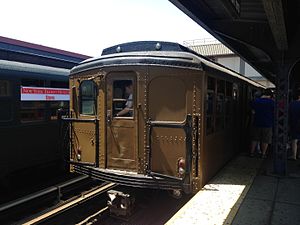BMT Standard
| AB Standard | |
|---|---|

AB Standard #2390 at the Brighton Beach station on June 25, 2016.
|
|

Interior view of AB Standard car #2204
|
|
| Manufacturer |
American Car and Foundry Company Pressed Steel Car Company |
| Constructed | 1914-1922, 1924 |
| Refurbishment | 1959-1962 |
| Scrapped | 1960-1969 |
| Number built | 950 (2 additional cars delivered with the 1919 group to replace cars damaged the previous year |
| Number preserved | 5 |
| Number scrapped | 945 |
| Formation | See letter designations below |
| Fleet numbers | 2000–2599 (ACF motors) 2600–2899 (Pressed Steel motors) 4000-4049 (Pressed Steel trailers) |
| Capacity | 260: 78 (seated) 182 (standing) |
| Operator(s) |
Brooklyn Rapid Transit Company Brooklyn–Manhattan Transit Corporation New York City Transit Authority |
| Specifications | |
| Car body construction | Riveted Steel |
| Car length | 67 ft 6 in (20.57 m) |
| Width | 10 ft 0 in (3,048 mm) |
| Height | 12 ft 1 1⁄8 in (3,686 mm) |
| Floor height | 3 ft 1 1⁄8 in (0.94 m) |
| Doors | 6 |
| Maximum speed | 45 mi (72 km) per hour |
| Weight |
Motor car: 96,320 lb (43,690 kg) Trailer car: 80,162 lb (36,361 kg) |
| Traction system |
Motor car: Westinghouse ABF 214 or 480, with Westinghouse 27B master controller, using GE 248A motors (140hp each). 2 motors per car (1 per truck). Trailer car: None |
| Power output | 140 hp (104 kW) per traction motor |
| Auxiliaries | Edison B4H (32 Volt) battery with 24 cells. Battery charged primarily by air compressor and trickle charged by car's main lights. |
| Electric system(s) | 600 V DC Third rail |
| Current collection method | Top running Contact shoe |
| AAR wheel arrangement |
Motor car: 1A-A1 Trailer car: 2-2 |
| Bogies | A-55 Maximum Traction Truck |
| Braking system(s) | WABCO Schedule AMUE with UE-5 universal valve, ME-23 brake stand, and simplex clasp brake rigging. Air provided by WABCO D-3-F Compressor. |
| Coupling system | WABCO H2A |
| Track gauge | 4 ft 8 1⁄2 in (1,435 mm) |
The AB Standard was a New York City Subway car class built by the American Car and Foundry Company and Pressed Steel Car Company between 1914 and 1924. It ran under the operation of the Brooklyn Rapid Transit Company (BRT) and its successors, which included the Brooklyn–Manhattan Transit Corporation (BMT), the New York City Board of Transportation, and the New York City Transit Authority (NYCTA).
In their earliest days of service, operating crews frequently called them Steels to distinguish them from the wooden BU elevated cars. However, these cars were most commonly referred to as BRT Standards, BMT Standards, or simply Standards. Train crews and the car shop departments often referred to them as 67-foot cars, AB-types, or most frequently AB's. For their time, the cars introduced a significant number of improvements to urban rapid transit.
When the BRT was to begin operating new subway lines that had been planned under the Dual Contracts of 1913, it marked the BRT's entry into providing subway service in New York. Previously, the BRT had only provided passenger rail service on elevated or surface routes. Expansion into the subway meant the BRT had to design a subway car suitable to run underground in tunnels. This also meant the new cars would have to be very different from the BRT's elevated fleet, and significantly stronger. The BRT was a forward-thinking company, and sought to design a car that improved upon those already in use on the IRT subway.
To do this, the BRT hired engineer Lewis B. Stillwell to design the cars, based on his work in the railway industry. It was known ahead of the actual signing of the Dual Contracts that the BRT was to operate subway routes, so the engineering effort actually began prior to 1913. Stillwell completed his initial designs for the new 67 foot Standard cars by 1912. In September 1913, a wooden mockup of Stillwell's Standard design was placed on display in Brooklyn for the public and received generally positive reviews. This was enough to go ahead with an order of the new cars.
...
Wikipedia
